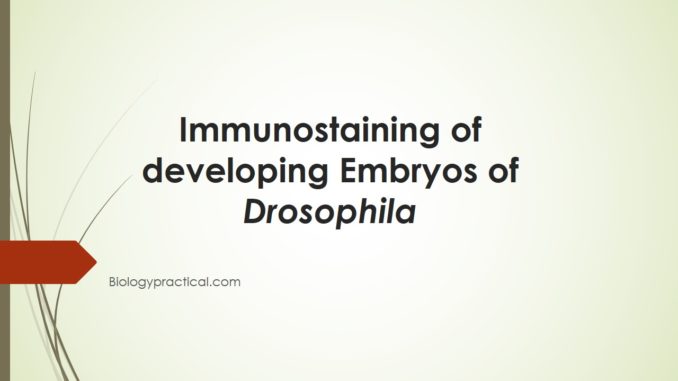
Embryonic development of Drosophila
- A series of rapid nuclear cycles takes place during the first few hours of Drosophila development, some of cycles take as little as 10 minutes. This high mitotic activity provides the early Drosophila embryo a very useful system to study various aspects of cell cycle and chromosome behaviour.
- For the study of these processes, it is essential to apply immunofluorescence-based techniques to visualize the subcellular organelles or the molecules under study.
- Apart from its own cell membrane, the Drosophila embryo is enclosed by the vitelline membrane and the chorion.
- These membranes being impermeable to most chemicals, it must be removed for the fixatives to penetrate the embryo.
- The removal of the chorion is technically very simple and is harmless to the embryo.
- The removal of the vitelline membrane can be done only after fixation of the embryo.
- The need to sort out this understanding between vitelline membrane removal and embryo fixation is the character specific to the protocols for immunostaining Drosophila embryos.
- Even if the basic procedure remains unchanged, many of the details of the protocols for immunostaining embryos have been modified, and others have been removed altogether.
Protocol for immunostaining Drosophila embryos.
- Allow flies to lay eggs on 3 % agar plates containing 4 % fruit juice.
- Brush the embryos from the collecting trays in 0.7 % saline and place them on a nylon gauze in a Millipore filtration funnel.
- Remove the chorion by passing commercial bleach over the embryos for 3 minutes.
- Wash thoroughly with water.
- The embryos can be processed immediately after any of the fixation protocols described later OR, they can be poured onto a dry plastic Petri dish, and covered with water so that they can be kept alive and at the same time be easily observed under the dissection micro- scope. This allows the selection of those embryos that have reached a particular developmental stage.
- If formaldehyde fixation (4%or 37%) is chosen, proceed to step 5. If methanol fixative is to be used, go directly to step 6.
- Transfer the embryos into a glass vial containing 1 ml of either 4 % or 37 % formaldehyde and 4 ml n-heptane. Incubate in spinning wheel for 20 minutes.
- Place the embryos into a microcentrifuge tube containing 500
methanol and 500
µl heptane. Invert the tube several times. Most embryos will lose their vitelline membrane and sink to the bottom of the vial.
- Remove all heptane and as much methanol as possible.
- Add fresh methanol.
- If the embryos were not fixed with formaldehyde, keep them in methanol for a further 2 hours at room temperature or overnight at 4°C.
- Rehydrate in phosphate-buffered saline (PBS)
- Block any residual fixative by incubating the embryos in 10% fetal calf serum (FCS), 0.3% Tween in PBS for 1 hour.
- If RNase treatment is to be carried out, an aliquot of a boiled solution of the enzyme should be added at this time at a concentration of 2 mg/ml.
- Incubate the preparation with the primary antibody in 10% FCS, 0.1% Tween in PBS either at 4°C overnight, or for 4 hours at room temperature.
- Wash several times with 0.1% tween in PBS over a I-hour period.
- Incubate with the secondary antibody for 4 hours at room temperature or overnight at 4°C.
- Wash as before, but using PBS alone for the last two or three washes.
- To mount, place a drop of approximately 50 µl of mounting medium on a microscope slide and transfer the embryos into the drop. Move them around with a pair of twizers until they get embedded, cover with a coverslip, and seal the preparation with nail varnish.
